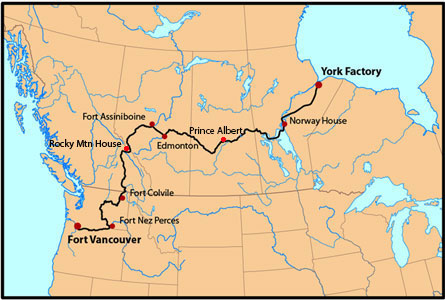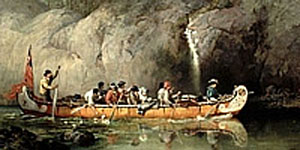JOHN PARK (1770-1847)
John PARK was born around 1770 in the Orkneys of Scotland (Burra).
A Voyageur and Trader with the Hudson’s Bay Company
On June 1, 1792 John PARK signed his first contract with the Hudson’s Bay Company (HBC). He began his career as a Voyageur (Bowsman) in the York Factory District.
On Oct 12, 1792, Sir Alexander MacKENZIE (1764-1820) of the North West Company (NWC) departed from Fort Chipewyan on his famous overland trip to the Pacific. He followed the Peace River into the Rockies, crossed the Continental Divide, followed the turbulent Fraser River down the western slopes, and finally reached the coast by way of the Bella Coola River on July 19, 1793.
Voyageur Route to the Pacific
During the summer and winter of 1796 John was a Bowsman with Inland Trader Malcolm ROSS (1755-1799). They spent the winter of 1796-97 on the western shore of Reindeer Lake at Bedford House, a trading post built by David THOMPSON (1770-1857).
Across the Rocky Mountains with Joseph HOWSE
John was working under Joseph HOWSE (1774-1852) when he spent the winter of 1809-10 at Edmonton House. When the historic Howse Expedition set out for the Columbia with seventeen servants and four natives for the Columbia, John was assigned the important canoe position as Steersman. HOWSE has been described as the first HBC man to cross the Rocky Mountains . In the HBC Archives John PARK was described by a superior as “A Strong Man, a Good Servant, and a better Steersman is not in the service”.
From 1812 until he retired, John remained in the Saskatchewan District as a steersman and Trader.
John marries a Métis Woman named Margaret
In 1815 John became the Assistant Trader at Edmonton. It was around this time that he began a connubial relationship with a Métis woman named Margaret.
HBC – NWC Union
In 1821 union of the North West Company (NWC) and the Hudson’s Bay Company (HBC) occurred, ending years of bitter rivalry for dominance of the fur trade in Western Canada. (Sir) George SIMPSON (1786-1860) became the Governor of Rupert’s Land.
After the merger, almost 1,300 employees lost their jobs since the single HBC organization that emerged had no need for most of the voyageurs and retired fur traders. John was among the retirees who settled in St Andrews Parish along the Red River.
In the Red River Census of 1827, John and his wife were recorded with two sons and three daughters under the age of 16. He had a house, barn and stable; four horses; a bull, eight cows and five calves; five hogs and three oxen. He also had a canoe; three carts; a plow and two harrows and he had eight acres under cultivation.
In 1831 Reverend William COCKRAN (1798-1865) and his wife moved to “The Rapids” (now St Andrews) where he built the first Anglican Church (a log structure). On May 1, 1832, the Church was opened and dedicated, and Reverend David JONES (1796-1844) promoted the establishment of a boarding school near the church, “to educate the sons of the gentlemen of the fur trade”. It was decided that girls could attend as well.
In 1832 construction of Lower Ft Garry was begun. This new fort became an important trading center for supplying goods to northern fur trading posts and packing furs for shipment to York Factory. The fort, constructed from large blocks of limestone, also provided protection from the threat of unfriendly Indians and other enemies.
In 1839 daughter Catherine became the second wife of John CROMARTIE (1792-1870), an HBC sailor from the Orkneys.
Around 1846 son George married Julia GUIBOCHE of uncertain origins; possibly an Indian woman from the St Peters Reserve.
In 1847 daughter Margaret married John IRVINE, son of Mary (Indian) & John IRVINE (1813-1904).
On Aug 8, 1847 John PARK died.
On Dec 19, 1849 Bishop David ANDERSON (1814-1883) consecrated the new stone church built in the area of the Rapids by Rev. COCKRAN. It was named St. Andrews after the patron saint of Scotland. The majority of the settlers here came from the Orkney Islands in Scotland. The area from then on became known as St. Andrews.
Around 1853 Margaret PARK died; buried in the old St Andrews Church Cemetery.
Around 1856 son James married Margaret INKSTER, daughter of Letitia SUTHERLAND & James INKSTER (1809-1888).
Please post comments & queries at this link: FORUM DISCUSSING JOHN PARK and his FAMILY
============================= Family Details =============================
Children: 2. Jun 5, 1823 CATHERINE PARK (m. John CROMARTIE)
|


